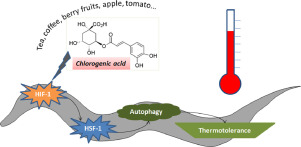Phytomedicine ( IF 6.7 ) Pub Date : 2019-11-04 , DOI: 10.1016/j.phymed.2019.153132 Andrea del Valle Carranza , Alejandra Saragusti , Gustavo Alberto Chiabrando , Fernando Carrari , Ramón Asis

|
Background
Chlorogenic acid (CGA) is a polyphenol widely distributed in plants and plant-derived food with antioxidant and protective activities against cell stress. Caenorhabditis elegans is a model organism particularly useful for understanding the molecular and biochemical mechanisms associated with aging and stress in mammals. In C. elegans, CGA was shown to improve resistance to thermal, while the underlying mechanisms that lead to this effect require further understanding.
Purpose
The present study was conducted to investigate the underlying molecular mechanisms behind CGA response conferring thermotolerance to C. elegans.
Methods and results
Signaling pathways that could be involved in the CGA-induced thermotolerance were evaluated in C. elegans strains with loss-of-function mutation. CGA-induced thermotolerance required hypoxia-inducible factor HIF-1 but no insulin pathway. CGA exposition (1.4 µM CGA for 18 h) before thermal stress treatment increased HIF-1 levels and activity. HIF-1 activation could be partly attributed to an increase in radical oxygen species and a decrease in superoxide dismutase activity. In addition, CGA exposition before thermal stress also increased autophagy just as hormetic heat condition (HHC), worms incubated at 36 °C for 1 h. RNAi experiments evidenced that autophagy was increased by CGA via HIF-1, heat-shock transcription factor HSF-1 and heat-shock protein HSP-16 and HSP-70. In contrast, autophagy induced by HHC only required HSF-1 and HSP-70. Moreover, suppression of autophagy induction showed the significance of this process for adapting C. elegans to cope with thermal stress.
Conclusion
This study demonstrates that CGA-induced thermotolerance in C. elegans is mediated by HIF-1 and downstream, by HSF-1, HSPs and autophagy resembling HHC.
中文翻译:

绿原酸通过HIF-1,HSF-1和自噬对线虫耐热胁迫的影响
背景
绿原酸(CGA)是一种多酚,广泛分布在植物和植物衍生食品中,具有抗氧化剂和抗细胞应激的保护作用。秀丽隐杆线虫是一种模式生物,对于理解与哺乳动物衰老和压力有关的分子和生化机制特别有用。在秀丽隐杆线虫中,CGA被证明可以提高耐热性,而导致这种作用的潜在机理尚需进一步了解。
目的
进行本研究以研究赋予线虫耐热性的CGA反应背后的潜在分子机制。
方法与结果
在秀丽隐杆线虫中评估了可能参与CGA诱导的耐热性的信号通路功能丧失突变的菌株。CGA诱导的耐热性需要缺氧诱导因子HIF-1,但没有胰岛素途径。热应力处理前的CGA暴露(1.4 µM CGA,持续18 h)增加了HIF-1的水平和活性。HIF-1激活可能部分归因于自由基氧种类的增加和超氧化物歧化酶活性的降低。此外,热应激之前的CGA暴露也增加了自噬,就像在高温条件下(HHC),蠕虫在36°C下孵育1 h一样。RNAi实验证明CGA通过HIF-1,热休克转录因子HSF-1和热休克蛋白HSP-16和HSP-70增强自噬。相反,由HHC诱导的自噬仅需要HSF-1和HSP-70。此外,自噬诱导的抑制显示了该过程对于适应的重要性。秀丽隐杆线虫应付热应激。
结论
这项研究表明CGA诱导的秀丽隐杆线虫的耐热性是由HIF-1和下游,HSF-1,HSP和类似HHC的自噬介导的。









































 京公网安备 11010802027423号
京公网安备 11010802027423号